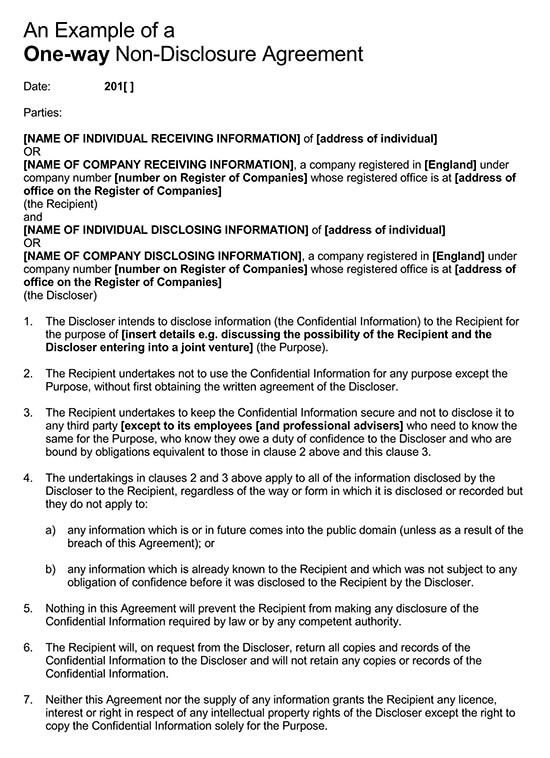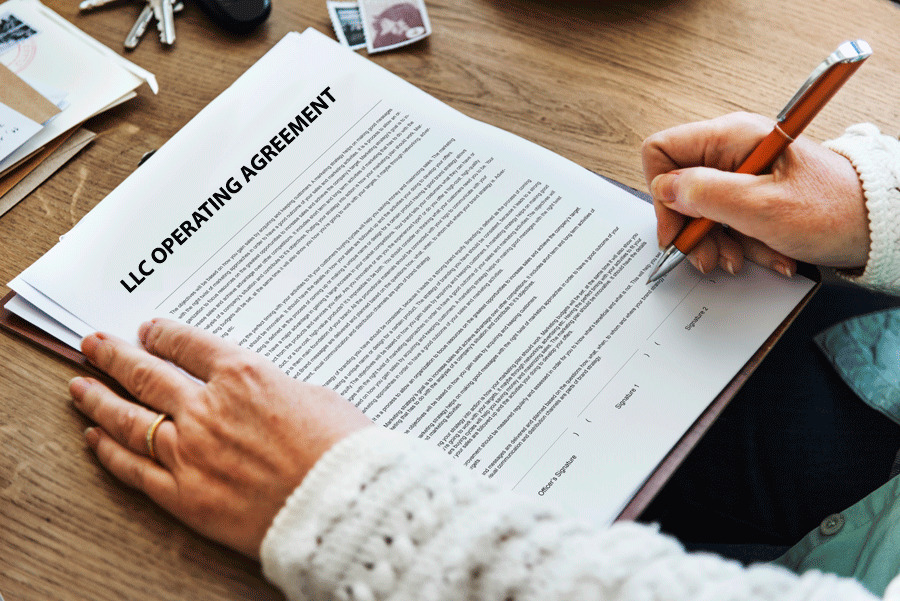A one-way non-disclosure agreement (NDA), also referred to as a confidentiality agreement, is a legal agreement between two or more parties that governs the disclosure and protection of confidential, proprietary, sensitive information, or trade secrets, between parties. The information can be disclosed either in writing and marked as confidential or can be summarized and labeled as confidential through a written memo delivered to the recipient within 30 days upon signing the NDA. This agreement makes it convenient for the Disclosing Party to disclose any information with the recipient, and the latter is bound to keep it private and retain the confidentiality of the information.
From the recipient’s point of view, the information disclosed should solely be used for evaluation or any other purposes as agreed upon by the involved parties.
EXAMPLE
If the recipient is a board owned organization/company/firm, then it is only allowed to share information with its own board members, officers, or employees to whom the information will help in dispensing their duties effectively.
The firm is tasked with ensuring that the entities with whom the information is shared do not disclose it to others. Even though the recipient may not have total control over the actions of others, it is, however, their responsibility to ensure that necessary precautions are taken to ensure that the information is not disclosed to unauthorized parties to maintain the integrity of the information.
There are two types of NDAs; Unilateral (One-way) and Mutual NDA. When entering or proposing an NDA, you must have the basic knowledge of both.
Unilateral (1-way) NDA Examples



Difference Between Unilateral NDA and Mutual NDA
- Unilateral NDA: one party agrees not to disclose confidential information that belongs to the other party
- Mutual NDA: Also referred to as a “2-way NDA”, it is used if two Parties are sharing information amongst themselves with the condition that they both keep it confidential.
When Should You Use a One-way Confidentiality Agreement?
You should consider using a unilateral agreement when:
- Sharing confidential information with another individual or business
- Imposing requirements on the use and disclosure of confidential information
- Imposing boundaries and restrictions on the use and disclosure of confidential information.
What Type of Information May be Protected by an NDA?
Basically, any information can be regarded as confidential. Both commercial and personal information is sometimes very crucial and needs to be protected; for instance,
EXAMPLE
You may choose to protect any confidential information that includes but not limited to: trade secrets, patents profile, product designs, databases, recipes, drawings, and clients’ information.
What is Included in a One-way Confidentiality Agreement?
A One-way Confidentiality agreement has:
- Definition of confidential information
- Protection of confidential information
- What and where the confidential information can be used
- Person(s) allowed to receive confidential information
- Disclosures required by law
- Ending the agreement
- Remedies in case of breach of confidentiality
Instances Where Confidential Information is not Considered Confidential
Confidential information may not be considered confidential if;
- The recipient obtains the information before disclosure by the disclosing party.
- The information is already in the public domain
- The information is obtained through a third party who is not a party to any agreements by the Disclosing party and is not in any way in violation of any laws or contractual obligations
- When it is a requirement by law or court order to disclose such information.
Remedies available for breach of the contractual agreement are relatively proportionate to the severity of damage done. In the event of a breach of information, the Disclosing Party is entitled to a percentage of profits that result from the breach of information, damages, or injunction.
Unilateral Non-Disclosure Agreement Sample
This Non-Disclosure Agreement (NDA) is entered into by and between…………… (The “Disclosing Party)……………………………… (The “Receiving Party”) conjointly referred to as the “parties” in this agreement to prevent the unauthorized disclosure of information as defined below.
i. Definition of Confidential Information
“Confidential Information,” as used in this document, shall hereby refer to any information either technical or non-technical that the Disclosing Party shall provide to the Receiving Party. The information, whether in writing or any other form such as oral, electronic, sketches, drawings, work of authorship, models, or any inventions, shall be deemed confidential in this agreement. If the information provided is in written form, then the Disclosing Party shall label or stamp the material with the word “CONFIDENTIAL” or any other comparable warning. Consequently, if the information is transmitted orally, the Disclosing Party shall, in writing, show that such oral communications constituted confidential information.
ii. Exclusion From Confidential Information
The receiving party in this agreement shall not be held accountable in the event of a breach of information if the information is: (a) already known to the recipient before the disclosure; (b) revealed or created by the Receiving Party before disclosure by Disclosing party; (c) obtained through a third party who is not a party to any agreements by the Disclosing party and is not in any way in violation of any laws or contractual obligations (d) a requirement by law or court order to disclose such information (e) disclosed to Receiving party before signing any agreement by Disclosing party.
iii. Notice of Non-Disclosure
The Receiving Party shall immediately notify the Disclosing Party upon discovering any loss caused as a result of the breach of contract or unauthorized disclosure of the Confidential Information.
iv. Relationships
This agreement shall in no way be considered to institute whichever party a partner, Joint venture, or Operative of the other party for any purpose of any kind.
v. Waiver
Any terms and conditions of this agreement shall be amended or waived only with the written consent of the Disclosing Party.
vi. Indemnity
The receiving party upon signing this agreement is bound to indemnify the Disclosing Party against any losses, claims, or expenses incurred or suffered as a result of receiving a party’s breach of this agreement.
vii. Choice of Law
Legitimacy, interpretation, construction, and presentation of this agreement shall be governed by laws of the State of (Disclosing Party Home State), without giving effect to the principle of conflict laws.
viii. The advice of Counsel
Each party acknowledges that in signing this agreement, it shall be binding, and has read and understood all the terms and conditions and provisions for this agreement.
Disclosing Party:
Signature………………………
Title: ……………………………..
Date………………………………
Receiving Party:
Signature…………………………
Title: ……………………………
Date…………………………….












